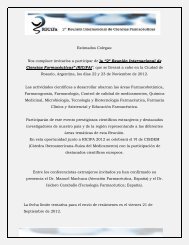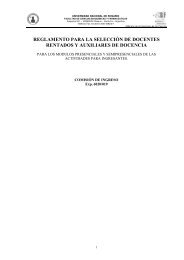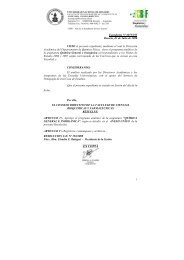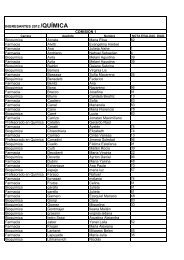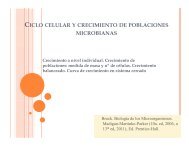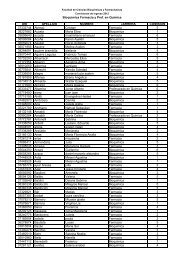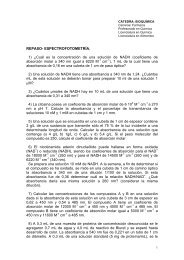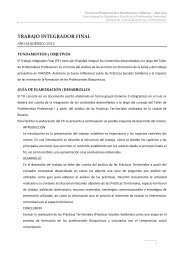PRACTICAL UTILITY OF DIFFERENT SYSTEMS FOR ...
PRACTICAL UTILITY OF DIFFERENT SYSTEMS FOR ...
PRACTICAL UTILITY OF DIFFERENT SYSTEMS FOR ...
You also want an ePaper? Increase the reach of your titles
YUMPU automatically turns print PDFs into web optimized ePapers that Google loves.
<strong>PRACTICAL</strong> <strong>UTILITY</strong> <strong>OF</strong> <strong>DIFFERENT</strong> <strong>SYSTEMS</strong> <strong>FOR</strong> CLASSIFYING DRUG-RELATED PROBLEMS (DRPs): ASSESSMENT BY HOSPITAL PHARMACISTS.Armando P 1a , Fontana D b , Uema S b , Vega EM ba Departament of Pharmacology, b Departament of Pharmacy. School of Chemical Sciences, NationalUniversity of Córdoba.Haya de la Torre y Medina Allende s/n, Ciudad Universitaria, Córdoba (Argentina) CP: 5000INTRODUCTIONThere are different classifications of DRPs with different focus (1). Both documenting and classifyingDRPs are essential to improve the process of medication’s use. In practice, professionals need a patientorientedbase to implement pharmaceutical interventions (1-6).Hospital Pharmacy Specialization (HPS) is a postgraduate career at the School of Chemical Sciences,National University of Córdoba (FCQ-UNC). Most of the HPS students are working in health-systempharmacies. One of the modules included the concept of DRPs and different classification systems.The objectives of this work are:• To assess the different DRPs classification systems through 4 clinical cases/examples resolved/classifiedby pharmacists taking the HPS (FCQ-UNC).• To analyze the opinions of participating pharmacists in relation to the focus and relevance of thedifferent DRPs classification systems.MATERIALS AND METHODSIn the frame of module “Pharmaceutical Care I” (HPS), a workshop intended to identify and classifyDRPs was planned. Four clinical cases with one DRP each (or DRP risk) were presented to six workinggroups of four pharmacists each. As few classifications have an official name, brief titles have beenassigned, usually referring to the originating organization or researcher(s).The groups resolved the cases by consensus using 4 classification systems: ASHP (7), 2nd GranadaConsensus (8), PCNE V 5.01 (9) and Cipolle/Morley/Strand (10). Ideally, one type of DRP was expectedby case according to each system (1,2). An average number of categories assigned by case was obtained.In addition, the groups were requested to assess the focus and practical utility of the DRPs classificationsystems (1,2). A 5 points Likert scale was used from “totally agree” to “completely disagree”. For focusassessment “completely disagree” was related to technical aspects while “totally agree” was associated toa patient-oriented process.For statistical analysis SPSS 15.0 software was used.RESULTSTwenty four pharmacists discussed the DRPs classification systems during the workshop. Main outcomesare shown in Table 1.CONCLUSIONSA comparison among different DRPs classification systems was carried out (1,2,3). Whereas an idealclassification system should identify uniquely a given DRP (1), Cipolle/Morley/Strand and 2nd GranadaConsensus seem to be better than the other systems (11). Moreover, both of them obtain high scores in thefocus and practical utility assessments.ACKNOWLEDGEMENTSTo Dr. María Eugenia Olivera (HPS director) and to all pharmacists from working groups.REFERENCES1. van Mil JW, Westerlund LO, Hersberger KE, Schaefer MA. Drug-Related Problem ClassificationSystems. Ann Pharmacother. 2004;38(5):859-67.2. Björkman IK, Sanner MA, Bernsten CB. Comparing 4 classification systems for drug-relatedproblems: processes and functions. Res Social Adm Pharm 2008;4(4):320-31.3. Björkman IK, Bernsten CB, Sanner MA. Care ideologies reflected in 4 conceptions of pharmaceuticalcare. Res Social Adm Pharm 2008;4(4):332-42.4. Lampert M, Kraehenbuehl S, Hug B. Drug-related problems: evaluation of a classification system inthe daily practice of a Swiss University Hospital. Pharm World Sci 2008;30:768-76.1 Corresponding author. Tel +54 351 4334437, fax +54 351 4334420; e-mail: parman@fcq.unc.edu.ar
5. Hämmerlein A, Griese N, Schulz M. Survey of drug-related problems identified by communitypharmacies. Ann Pharmacother. 2007;41(11):1825-32.6. Krähenbühl JM, Kremer B, Guignard B, Bugnon O. Practical evaluation of the drug-related problemmanagement process in Swiss community pharmacies. Pharm World Sci. 2008;30(6):777-86.7. American Society of Health-System Pharmacists. ASHP guidelines on a standardized method forpharmaceutical care. Am J Health-Syst Pharm.1996; 53:1713-6.8. Grupo de Investigación en Atención Farmacéutica. Segundo Consenso de Granada sobre ProblemasRelacionados con Medicamentos [The second Granada consensus on drug-related problems] ArsPharmaceutica 2002; 43:175-84. Spanish.9. Pharmaceutical Care Network Europe. DRP-classification V5.01 [Internet]. [cited 2009 Oct 23].Available from: http://www.pcne.org/Documents/DRP10. Cipolle RJ, Strand LM, Morley PC. Pharmaceutical care practice. New York: McGraw-Hill, 1998:78-9.11. Costa S, Santos C, Madeira A, Santos MR, Santos R. Using two different Classifications of DrugRelated Problems in community pharmacies - the Portuguese experience. Seguim Farmacoter 2004; 2(4):267-85.Table 1: Practical comparison among different DRPs classification systemsDRPs classificationsystemAverage number ofcategories assignedFocus*Practical utility*ASHP 2,0 2,3 ± 0,5 2,0 ± 0,8Cipolle/Morley/Strand 1,1 4,3 ± 0,5 4,3 ± 0,52 nd Granada Consensus 1,0 4,3 ± 0,5 4,0 ± 0,0PCNE V 5.01 1,6 1,8 ± 0,5 2,0 ± 0,8* 5 points Likert scale ± SD




